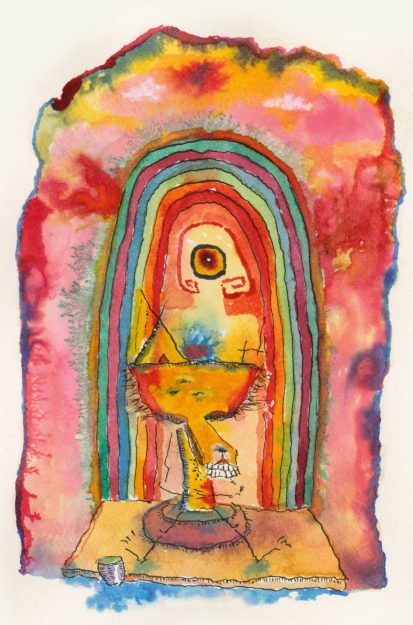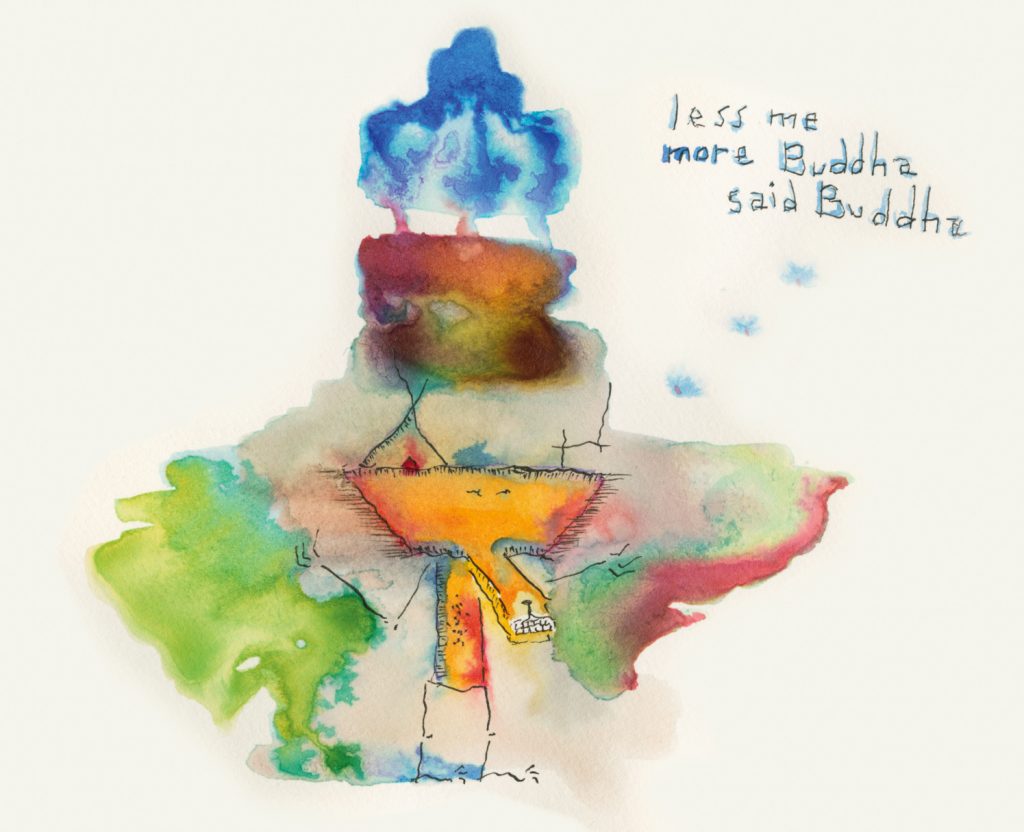You’ve made it to the final week. Acknowledge your hard work and recognize the joy that comes from following through on a commitment. In this final week we will further develop the skills we have worked on over the last twenty-one days and will expand our realm of focus to include thoughts.
Working with Thoughts
For the purpose of meditation, nothing is particularly worth thinking about: not our childhood, not our relationships, not the great novel we always wanted to write. This does not mean that thoughts will not come. In fact, they may come with tremendous frequency. We do not need to fight with them or struggle against them or judge them. Rather, we can simply choose not to follow the thoughts once they have arisen. The quicker we notice that we are thinking, the quicker we can see thought’s empty nature.
Our thoughts are often seductive, and meditation may pass quickly when we sit and daydream; before we know it, the hour has passed. It may have been an enjoyable sitting, but it was not meditation. We need to be aware of this sidetrack in practice and remember that the kind of wisdom we want to develop comes intuitively and spontaneously from silent awareness.
Although meditation is not thinking, it can be clear awareness of thinking. Thought can be a very useful object of meditation. We can turn the great power of observation onto thought in order to learn about its inherent nature, becoming aware of its process instead of getting lost in its content.
In dharma teaching we speak frequently about the powerful impact of identifying with phenomena. Identification imprisons us in the content of our conditioning. One of the easiest ways to understand this imprisonment is to observe the difference between being lost inthought and being mindful of it.
The Buddha said that we are shaped, created, and led by our thoughts. If he was right, then it is important for us to watch our thought process closely to see where we get hooked, where we are seduced through identification into creating something that brings us unhappiness. It is amazing to observe how much power we give unknowingly to uninvited thoughts: “Do this, say that, remember, plan, obsess, judge.” They can drive us quite crazy, and they often do!
The kinds of thoughts we have, and the impact they have on our destiny, depend on our understanding of things. If we are in the clear powerful space of just seeing thoughts arising and passing, then it does not matter what species of thinking appears in the mind; they are all essentially empty of any substance at all, and we can see them for the passing show that they are. These all-powerful movers and shakers of the world that create us and lead us become little energy blips in our mind, with hardly enough power to create even a ripple. They seem like transparent dewdrops evaporating in the sun.
But there are many times when we are not simply watching thoughts come and go, either because we are lost in them or because we choose to think something through, perhaps as a precursor to action. In both cases it is crucial for us to discern wholesome from unwholesome thoughts in order to know which to give our energy to, because these thoughts do have karmic impact: they lead us. From thoughts come actions. From actions come all sorts of consequences. Which thoughts will we invest in? Our great task is to see them clearly, so that we can choose which to act on and which simply to let be.
It takes a great deal of alertness to stay aware of thoughts. They are extremely slippery. If you watch them in one place, they sneak in from another. But as practice evolves, two liberating things happen. First, our mind actually becomes quieter. Instead of being a rushing torrent, thoughts come less frequently, and we enjoy an increasing sense of calm and inner peace. Second, our observing power becomes quicker and stronger. We can see thoughts much more clearly and are taken for fewer unconscious rides. Without identifying with thoughts and giving them power, our mind abides in a natural state of ease, simplicity, and peace.
Guided Meditation: Counting Thoughts
As you sit, resolve to concentrate on the thought process for five minutes. Let your mind appear as a blank screen, and watch carefully for thoughts to arise. They may come as images, or words in the mind, or both together. Some thoughts may arise with a feeling or physical sense as well. Note experience as it appears.
For five minutes, experiment with counting your thoughts. After noticing and counting the thoughts, simply wait, looking at the blank screen, for the next one to arise. Remember that some thoughts are very subtle, like “It’s so quiet in here.” We count the thoughts not to form a judgment about ourselves and how much (or little) we think, but to observe the thought process with mindfulness, without getting lost in each story. Can you describe your experience?
Carefully note each breath as “breath.” As thoughts arise, note them simply as “not-breath.” This also helps us cut our dualistic fixation with the content of our thoughts. Whether lovely or frightening, they are all noted simply as “not-breath.” What kinds of thoughts predominate in your mind—words or pictures, those arising with a kinesthetic sense, or a combination?
If images are arising, can you note them as “seeing” and notice whether they are growing brighter, fading, breaking apart, moving closer, or staying just the same? Can you note the particular kind of thought, such as “planning,” “remembering,” “judging,” “loving”?
Observe the effect of various types of thoughts—for example, of a future-directed thought like “I’m never going to get any better.” What happens to your mood, to your body, as a consequence of this thought? What is the difference between simply observing it and getting lost in it?
Can you name an insistent thought with a label that reflects some compassion and humor? We call them the Top Ten tapes because they arise in the form of conditioned tapes in the mind. They play like songs on the radio, reflecting the same themes over and over again. Try giving them appropriate labels like “the Martyr tape,” “the I-Blew-It-Again tape,” “the Fear-of-the-Dark tape.” Be lighthearted about these labels. We can see these tapes as conditioned forces and don’t have to take ourselves so seriously. The repeated forces in the mind can be greeted in a friendly and openhearted way: “Oh, it’s you again, Mad Scientist tape. Hello.”
If a particular thought seems to be returning a lot, expand your field of attention to notice whatever emotional state may be feeding it. Unseen feelings are part of what brings thoughts back again and again. For example, anxiety often fuels future planning. At first the emotions may be half-hidden or unconscious, but if you pay careful attention, the feelings will reveal themselves. Use the sensations in the body to help guide the attention to whatever emotions may be present. You may find that watching tension in the chest uncovers sadness. Begin to note whatever emotion you see as a way of acknowledging them.
If there is a repeated physical pain or difficult mood, expand your field of attention to the thoughts, stories, or beliefs that may be feeding the difficult situation. When we are mindful, we may find a subtle level of self-judgment or a belief about our unworthiness, such as “I’m not as good as others. I’ll always be this way.” These thoughts actually help perpetuate pain or unhappiness.
Monday–Friday: Increase your seated-meditation commitment to forty-five-minute sessions in the morning and in the evening. Also include two periods of walking meditation, of any length, in the course of the day
Weekend Challenge: Devote one full day (from sunrise to sunset) to contemplation on the body, the feelings, and the mind in silence. Create a schedule of alternating periods of seated and walking meditation with short breaks in the morning and afternoon and one two-hour lunch break. During break periods move carefully, paying special attention to sensations in the body and activity in the mind. This is a good opportunity to learn how to take your mindfulness practice off the cushion and into your everyday life.
You’ve done it!
 Congratulations on completing the Commit to Sit challenge. But don’t stop here. The challenge now is to incorporate your newly cultivated wisdom, peace, and diligence into your busy life. Reflect on your efforts this month and think about how the process has unfolded for you in ways both expected and unexpected. Can you sense any change in your thought patterns and quality of attention? What commitments to meditation practice and ethical conduct would you like to keep? Take what you have learned about the practices and yourself and formulate a daily practice that works for you, and if you’re still feeling adventurous, look into other kinds of retreats you might like to try. Visit tricycle.com’s Commit to Sit page for links to retreat centers, forums to share your experience with fellow retreatants, and advice from teachers on how to continue to develop your hard-earned concentration and tranquility.
Congratulations on completing the Commit to Sit challenge. But don’t stop here. The challenge now is to incorporate your newly cultivated wisdom, peace, and diligence into your busy life. Reflect on your efforts this month and think about how the process has unfolded for you in ways both expected and unexpected. Can you sense any change in your thought patterns and quality of attention? What commitments to meditation practice and ethical conduct would you like to keep? Take what you have learned about the practices and yourself and formulate a daily practice that works for you, and if you’re still feeling adventurous, look into other kinds of retreats you might like to try. Visit tricycle.com’s Commit to Sit page for links to retreat centers, forums to share your experience with fellow retreatants, and advice from teachers on how to continue to develop your hard-earned concentration and tranquility.
♦
Commit to Sit: Tricycle’s 28-day meditation challenge
|
|
Introduction |
Working with Aversion |
The Five Precepts |
Working with Metta |
Week 1: The Breath |
Working with Sense Doors |
Week 2: The Body |
Seated Meditation Tips |
Week 3: Emotions & Hindrances |
Working with Hindrances |
Week 4: Thoughts |
Meditation Supplies |
Posture |
7 Simple Exercises |
Thank you for subscribing to Tricycle! As a nonprofit, we depend on readers like you to keep Buddhist teachings and practices widely available.
